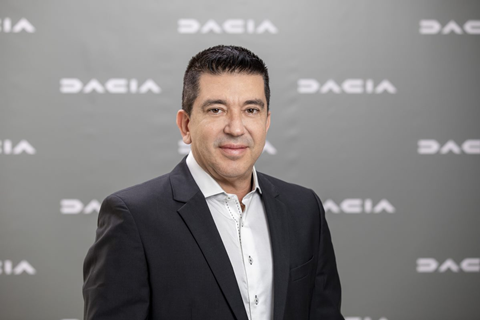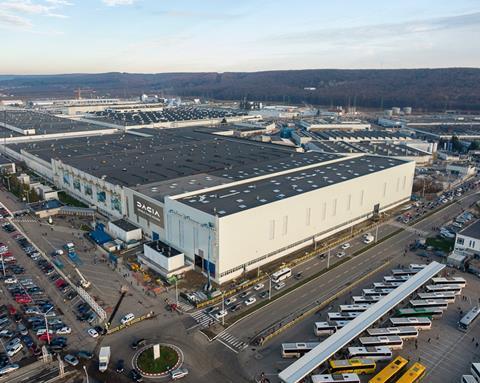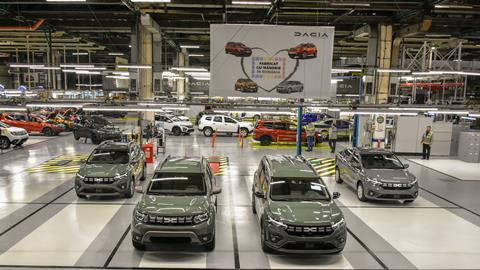Speaking to AMS, Carlos Carrinho, General Manager Dacia Vehicle plant Mioveni, discusses the factory’s unique position within the realm of European car manufacturing and how it has been continuously developing to meet future production challenges
Vehicle production in Europe has recently been hit with a wave of challenges. From the semiconductor supply shortage to labour shortages, the continued fallout of the Covid-10 pandemic, rising inflation and the war in Ukraine, carmakers in the region are contending with some of the most difficult conditions, many of which were discussed in detail at the AMS Evolution Europe summit held in Germany last year.

Looking ahead, the transition to electric vehicle production may cause serious headaches for those with existing production facilities. Some plants might only need updating to add the necessary processes, while others could require a complete overhaul to ensure EVs can be made efficiently and effectively, allowing the factory to operate in an extremely competitive market.
But it’s not all doom and gloom. At its factory in Mioveni, Romania, Dacia recorded impressive production figures during 2022 in relation to pre-pandemic levels, and the company hopes its future in Europe will flourish. Speaking to AMS, Carlos Carrinho, General Manager Dacia Vehicle plant Mioveni, describes the history of the factory and explains its unique position within the realm of European car manufacturing.
Can you provide some background on the history of the Mioveni plant, and how it became an integral facility for Dacia?
Carlos Carrinho (CC): The history of the Mioveni plant is closely linked to that of the Dacia brand. In the mid-1960s, the communist authorities in Bucharest decided that Romania should become a car-producing country. Considering the lack of local experience in this field, the solution was chosen to purchase a manufacturing license from a Western carmaker. The tender organised for this purpose in 1966 was won by Renault, which offered the production of the Renault 12.
In parallel with the decision about which car model was to be manufactured, the construction of the production plant also began, the location of which was established in Mioveni, a suburb of the city of Pitesti, located 120km northwest of Bucharest. The factory was inaugurated in August 1968 and the first model to be produced was the Renault 8, assembled locally under the name Dacia 1100. In 1969 the assembly of the Renault 12 model began, known in Romania under the name Dacia 1300. Currently, the Mioveni plant has an annual production capacity of 350,000 vehicles and produces four models in the Dacia range: Duster, Logan, Sandero and Jogger.
In April 2022 Dacia celebrated 10m vehicles produced since the formation of the brand. How integral has the Mioveni plant been to this?
CC: The Mioveni plant was, until 2005, the only manufacturing plant of the Dacia brand. Even later, after the start of production in Casablanca and Tangier, the Mioveni plant continued to be the largest in terms of production. We call it the Dacia mother-plant. The figures speak for themselves: of the 10m Dacia vehicles produced from 1968 to April 2022, 7m were manufactured in Romania.
When did you become the director of the plant, and have there been any major changes since you took charge?
CC: I took management of the factory in Mioveni at the beginning of 2022. It was a great year, in which I passed, together with my colleagues, through numerous challenges, but a year that ended well. We produced a total of over 310,000 vehicles, which is close to pre-crisis levels.
One big change I’ve been part of is the new brand identity for Dacia vehicles, which entailed significant work to adapt body and interior parts to the requirements of the new Dacia emblem and logotype. For my colleagues in manufacturing, this required excellent planning as we had to switch seamlessly from manufacturing the cars with the previous branding elements to manufacturing the cars with the new design.
What makes the Mioveni plant unique and an exciting place to work?
CC: First, Dacia is a unique project in the automotive industry. It is a very dynamic brand with a range of models that are best sellers in their respective segments and with commercial performances that no one would have anticipated just ten years ago. For me personally, working at Mioveni, the mother plant of the Dacia brand, represents an important moment in my professional career. Equally important is the fact that I have the chance to work here, in Romania, with a team of true professionals.
How important is the location of the plant? Do you have a supply base nearby for parts, and is it a strategic location to export vehicles around the world?
CC: The Mioveni plant is located near one of the most important transport axes of Romania – the route that connects the capital, Bucharest, with Western Europe, passing through Transylvania. It is a route which will be entirely covered by expressway standards in the next few years. Numerous suppliers are implanted near the plant, two of them having production capacities right on the Mioveni platform. Also, our research and development centre, which comprises extensive testing facilities, is located halfway between the plant and the Bucharest head office and design centre. This is a very efficient set-up hosting our eco-system of activities. As for exports, they represent over 85% of the factory’s annual manufacturing volume. Among the main destinations of cars produced at Mioveni are France, Italy, Germany, Spain, and the United Kingdom.
How has digitalisation and automation had an impact on your labour force?
CC: The background is important to understand, particularly with what has happened in the labour force over the past ten years. We are an important employer for the local area, and this reflects in the way in which we behave on the labour market. We have strengthened ourselves to cover the whole value chain. We are not just a manufacturing company. We are a technology company with manufacturing, engineering, shared services, and an IT hub. Most of the time, people look at us as just a factory building cars. Automation is particularly important for production, but all the other functions have been flourishing as a result of increased digitalisation too.
Our portfolio of skills is very diverse. Romania is an engineering hub for the world, we are even doing work for Nissan in Japan. When you go to our engineering centre in Titu you see engines from all over the world. We use virtual reality for designing and testing vehicles without building physical prototypes. This is a major innovation in terms of automation and digitalisation. It has saved us a lot of money, but it has also required a lot of adaptation.

Is the push to electric vehicles having an impact on the Mioveni plant?
CC: Regarding sustainability, Dacia vehicles are designed to be economical, and have been from the very beginning. Even in 2004 with the Logan project, we were aiming to make cars eco-friendly. Our cars are always well sized and have adapted engines. We are currently oriented towards the promotion of LPG (liquid petroleum gas) and in the next stage of hybrid engines. We are also studying the use of synthetic fuels and, at the same time, we are preparing for the future of electrification.
Our manufacturing roadmap is aligned to the Dacia brand strategy – the brand offering its customers the essentials in terms of technology. Dacia has access to Renault Group expertise in terms of electrification, digitalisation and automation, and will add specific features on its vehicles at the right moment.
Are there any particularly unique or interesting areas of the plant processes technologies that you would like to highlight?
CC: The plant in Mioveni has a high degree of integration. On the same platform, next to the vehicle plant, there is a mechanical and chassis plant, the latter including an aluminium foundry which is not only the largest in Romania but also the largest in the entire Renault Group. We have a high-speed pressing facility and an ultra-modern line ready to take on increased capacity when the need arises. We also have AILN at Mioveni – the largest logistics centre in the Renault-Nissan-Mitsubishi Alliance in terms of the volume of parts shipped.
What are your goals and aspirations for the plant?
CC: I hope that Mioveni will remain the reference plant of the Dacia brand, an example of efficiency and quality, ensuring the most solid basis for the expansion of the brand in the C-segment. In terms of the evolution of the plant, I believe that the organisation of production processes will evolve significantly because of new standards for energy efficiency and increasingly strict regulations for environmental protection. The Mioveni factory of the future will obviously become greener and more efficient.






































No comments yet